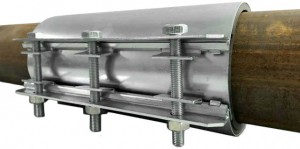
For repair (sealing cracks and holes) and connecting pipes made of various materials, special devices are used - repair couplings. Read about repair couplings, their existing types, design and applicability, as well as the correct choice and use of these products in the presented article.
What is a repair coupling?
Repair coupling (repair clamp) - a device for sealing damage to pipelines or pipeline connections made of various materials; A one-piece or composite coupling fixed to the outer surface of the pipeline to seal it or to ensure a tight connection between two pipes, or to connect the pipe to various components.
Metal, plastic and metal-plastic pipes, as well as rubber and plastic hoses for various purposes during long-term operation are exposed to a variety of negative influences, as a result of which they can be damaged. In case of significant damage, the pipeline must be completely replaced, however, in case of local defects - cracks or breaks, it is easier and cheaper to carry out repairs. And often there is a need to connect two pipes or one pipe with different components, but it is not possible to weld these parts. In all these situations, special devices come to the rescue - repair couplings.
Repair couplings, depending on the type and design, perform several functions:
● Repair of local damage to pipes - short cracks, breaks, holes, through corrosion;
● Connection of two pipes of the same or different diameter;
● Connection of pipes with additional shaped products, fittings and other parts.
In each case, the use of certain types of couplings and auxiliary materials is required. Therefore, before buying the right part, you should understand the existing types of couplings, their features and characteristics.
Types and design of repair couplings
The repair couplings on the market can be classified according to their purpose, functionality and applicability, design and method of fixation on the pipeline.
According to the purpose of the couplings are:
● Repair - to restore the tightness of the pipe;
● Connecting - to connect two pipelines or a pipeline with different components;
● Universal - can perform the functions of both repair and couplings.
According to the applicability, repair couplings are divided into several groups:
● For metal pipes - cast iron and steel;
● For HDPE and PP pipes of large diameter;
● For metal-plastic pipes of small diameter;
● For flexible pipelines (hoses).
Couplings for metal pipes are made of cast iron and steel (less often plastic), for other pipes and hoses - from plastics of various types (for HDPE and PP - from the same low-pressure polyethylene and polypropylene, for hoses - from various rigid and flexible plastics).
ccording to the method of installation and design, repair couplings are divided into two large groups:
● Sliding;
● Convoluted.
Sliding couplings are the simplest products in design and use, which are usually designed for PP and HDPE pipes (sewer, water). Such a coupling is made in the form of a short piece of pipe, the end parts of which have extensions (sockets) for the installation of sealing rubber rings. The coupling is mounted on the pipe with a sliding - it is put on the free end and moves to the place of damage, where it is fixed with glue or otherwise. Sliding couplings are often used as couplings for splicing two pipes or connecting fittings, fittings and other components to the pipe after the installation of the entire pipeline system.
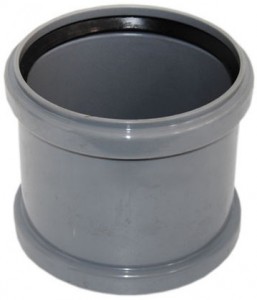
HDPE sliding type repair clutch
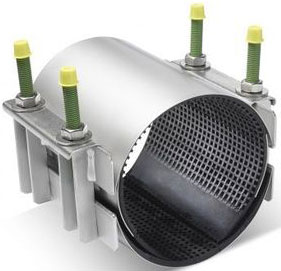
Two-lock convoluted coupling
Convoluted couplings are more complex products used for the repair of cast iron and steel pipes of various types and diameters (water and gas pipelines, sewers, etc.). Such couplings consist of several parts that are installed on the pipe and tightened with threaded fasteners (hence the name of this type of product), providing a tight crimping of the pipe at the site of damage.
Convolutional couplings, in turn, are divided into two design types:
● Rigid compounds;
● Tape (clamps).
Rigid couplings can be two-piece and three-piece, they consist of two or three half-couplings, which are connected to each other by threaded fasteners - two, three or more bolts with nuts. Usually, parts of two- and three-piece repair couplings are made by casting or stamping from cast iron and steel. But recently, plastic couplings designed for pipes of relatively small diameters have been increasingly used. Plastic products have a large number of bolted connections (while cast iron couplings use no more than three bolts for one connection), which evenly distribute the load and prevent the destruction of the coupling halves. The coupling comes with a rubber gasket that is clamped between the pipe and the coupling, sealing the attachment point.
Tape couplings are made of one or two flexible steel shell bands (usually stainless steel), the ends of which are tightened together with threaded fasteners, forming a lock. Couplings come with one and two locks, in the first case, only one shell tape is used (as well as an additional liner that overlaps the lock place), in the second case, two tapes, which makes this type of product similar to two-part rigid joints. These couplings also use a rubber gasket.
Collet-type compression couplings for splicing hoses and plastic pipes of small diameter are allocated in a separate group. The basis of the coupling is a plastic case in the form of a short piece of pipe with an outer diameter corresponding to the inner diameter of the pipes to be connected. The ends of the case are divided by cutouts into separate flexible petals, and closer to the center the thread is made. Couplings of a certain configuration are screwed onto the thread, which, together with the housing petals, form a collet clamp. The connected pipelines (hoses) are installed in the collet, and when screwed on, the couplings are tightly clamped - this forms a tight and sufficiently strong connection without performing additional operations.
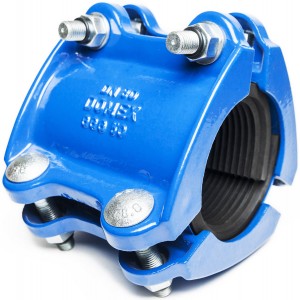
Two-piece convoluted repair coupling
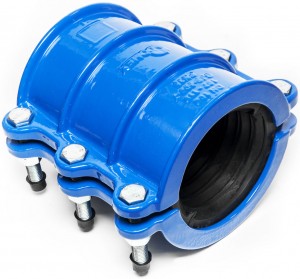
Three-piece convoluted repair coupling
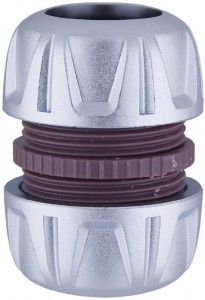
Characteristics of repair couplings
The main characteristics of repair couplings include their length (or pipe coverage area) and the diameter of the pipes to be connected. Rigid convolution and collet couplings are usually designed for pipes of a certain diameter, and convoluted sleeves made of shell tapes can be mounted on pipes of a certain range of diameters (usually this range is 5-20 mm depending on the size of the coupling). The diameter of the couplings is indicated in millimeters, and for water and gas pipes - in inches. The length of couplings for various purposes lies in the range of 70-330 mm, convoluted couplings have standardized lengths of 200 and 330 mm, sliding couplings for HDPE and PP pipes - up to 100 mm or more, and collet - no more than 100 mm.
Separately, it is necessary to indicate that there are collet and sliding couplings of variable diameter, designed to connect pipes of different diameters. Repair convolutions are only of constant diameter.
Selection and features of the use of repair couplings
When selecting repair or couplings, one should take into account the type and diameter of the pipes to be connected, as well as the nature of the work performed. The easiest way is to choose collet couplings for hoses - in such pipelines there are low pressures, so even a simple plastic product will provide a reliable connection without leaks. The main thing here is to find a coupling for the diameter of the existing hoses.
For the modernization of sewer pipes and water pipes based on plastic pipes, sliding couplings should be used. Moreover, the diameter of the product must exactly match the outer diameter of the pipes, with smaller or larger sizes, the coupling will either not fall into place, or the connection will be leaky. If you plan to make one-piece connections, then you additionally need to buy a special glue. If you need to repair a plastic pipe without the possibility of cutting it, you can use a tape convolution coupling.
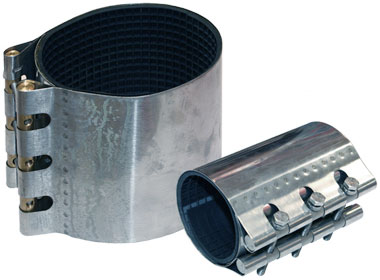
For the repair of steel and cast iron pipes, it is necessary to use convolutional couplings. As already indicated, rigid products must be accurately selected according to the diameter of the pipes, and the size of flexible ones can differ by several millimeters from the diameter of the pipe. If you need to perform urgent (emergency) repairs, it is better to use single-lock tape couplings, as they allow you to quickly eliminate the leak by tightening only two or three bolts. Couplings of these types are sold complete with rubber seals, so the purchase of additional parts is needed in rare cases.
Installation of repair couplings is simple, but requires careful performance of all actions. The sliding coupling is put on the pipe and moves along it to the place of damage, where it is fixed. The convolution coupling is installed in parts: a seal is wound on the pipe, half couplings are superimposed on it, which are bolted crosswise to ensure uniform crimping. When installing a single-lock tape coupling, it is necessary to lay a seal, put a coupling on the pipe, and put a liner under the lock place, and then tighten the bolts evenly.
With the right choice and installation of the repair coupling, the pipeline will serve reliably, without requiring complex and expensive repairs for a long time.
Post time: Jul-12-2023
